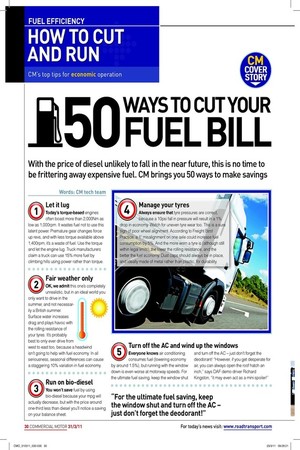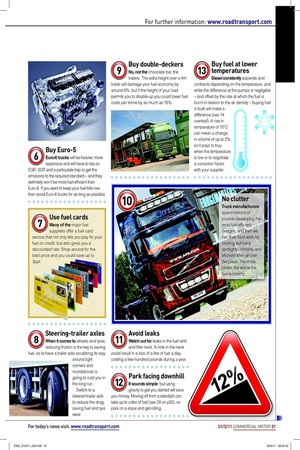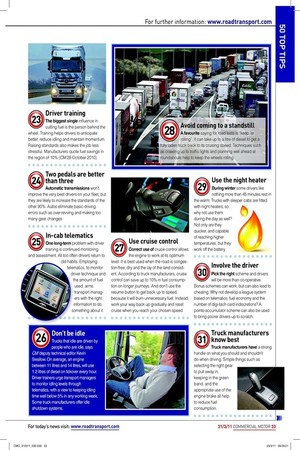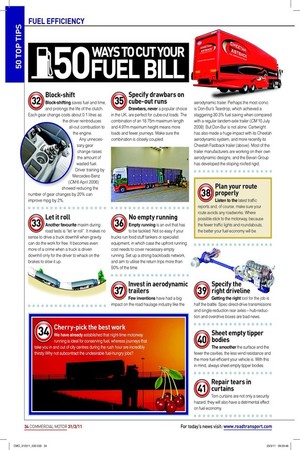WAYS TO CUT YOUR
Page 20

Page 21

Page 22

Page 23

Page 24

Page 25

If you've noticed an error in this article please click here to report it so we can fix it.
FUEL BILL
With the price of diesel unlikely to fall in the near future, this is no time to be frittering away expensive fuel. CM brings you 50 ways to make savings
Words: CM tech team
Let it lug
Today’s torque-based engines often boast more than 2,000Nm as low as 1,000rpm. It wastes fuel not to use this latent power. Premature gear changes force up revs, and with less torque available above 1,400rpm, it’s a waste of fuel. Use the torque and let the engine lug. Truck manufacturers claim a truck can use 15% more fuel by climbing hills using power rather than torque.
Fair weather only
OK, we admit this one’s completely unrealistic, but in an ideal world you only want to drive in the summer, and not necessarily a British summer. Surface water increases drag and plays havoc with the rolling resistance of your tyres. It’s probably best to only ever drive from west to east too, because a headwind isn’t going to help with fuel economy. In all seriousness, seasonal differences can cause a staggering 10% variation in fuel economy.
Run on bio-diesel
You won’t save fuel by using bio-diesel because your mpg will actually decrease, but with the price around one-third less than diesel you’ll notice a saving on your balance sheet.
Manage your tyres
Always ensure that tyre pressures are correct, because a 10psi fall in pressure will result in a 1% drop in economy. Watch for uneven tyre wear too. This is a sure sign of poor wheel alignment. According to Freight Best Practice, a 1º misalignment on one axle could increase fuel consumption by 5%. And the more worn a tyre is (although still within legal limits), the lower the rolling resistance, and the better the fuel economy. Dust caps should always be in place, and ideally made of metal rather than plastic, for durability.
Turn off the AC and wind up the windows
Everyone knows air conditioning consumes fuel (lowering economy by around 1.5%), but running with the window down is even worse at motorway speeds. For the ultimate fuel saving, keep the window shut and turn off the AC – just don’t forget the deodorant! “However, if you get desperate for air, you can always open the roof hatch an inch,” says DAF demo driver Richard Kingston, “it may even act as a mini spoiler!”
Buy Euro-5
Euro-6 trucks will be heavier, more expensive and will have to rely on EGR, SCR and a particulate trap to get the emissions to the required standard – and they definitely won’t be more fuel-efficient than Euro-5. If you want to keep your fuel bills low, then avoid Euro-6 trucks for as long as possible.
Use fuel cards
Many of the major fuel suppliers offer a fuel card service that not only lets you pay for your fuel on credit, but also gives you a discounted rate. Shop around for the best price and you could save up to 3ppl.
Steering-trailer axles
When it comes to wheels and tyres, reducing friction is the key to saving fuel, so to have a trailer axle scrubbing its way around tight corners and roundabouts is going to cost you in the long run.
Switch to a steered-trailer axle to reduce the drag, saving fuel and tyre wear.
Buy double-deckers
No, not the chocolate bar, the trailers. The extra height over a 4m trailer will damage your fuel economy by around 6%, but if the height of your load permits you to double-up you could lower fuel costs per tonne by as much as 15%.
No clutter
Truck manufacturers spend millions of pounds developing the most fuel-efficient designs, and then we ruin their hard work by sticking bull-bars, spotlights, airhorns and Michelin Men all over the place. The more clutter, the worse the fuel economy.
Avoid leaks
Watch out for leaks in the fuel tank and filler neck. A hole in the neck could result in a loss of a litre of fuel a day, costing a few hundred pounds during a year.
Park facing downhill
It sounds simple, but using
gravity to get you started will save you money. Moving off from a standstill can take up to a litre of fuel (see 28 on p33), so park on a slope and get rolling.
Buy fuel at lower temperatures
Diesel constantly expands and contracts depending on the temperature, and while the difference at the pumps is negligible – and offset by the rate at which the fuel is burnt in relation to the air density – buying fuel in bulk will make a difference (see 14 overleaf). A rise in temperature of 10ºC can mean a change in volume of up to 2%, so it pays to buy when the temperature is low or to negotiate a correction factor with your supplier.
Bunker fuel
Just like getting baked beans at the cash and carry, buying fuel in bulk will save you money. But remember to keep on top of the tank maintenance to avoid a visit from the Environment Agency.
Use synthetic oil
It’s not just tyres that suffer from friction – friction in the engine also affects your fuel economy. It’s therefore important to use the right oils, such as a high-grade synthetic one. Shell says its Rimula 5W/40 can save up to 1.1% in fuel consumption compared to its synthetic 10W/40 oil. Axles and gearboxes also work under friction, so check the manufacturer’s guidelines when servicing and making fluid changes.
Run on the right roads
Picking the routes with the most motorway miles will keep your mpg high, but have you considered how the surface of the road will affect your economy? Coarse-sealed coated asphalt has a rolling resistance almost one-third higher than rounded aggregate asphalt, while polished concrete is a further 10% more economical to run on. If only all routes were like the stretch between Junctions 9-10 on the M25.
Listen to the right music
Psychologists at the West London Institute of Higher Education found that drivers listening to loud, repetitive, quick, rebellious music drove in a similar fashion. They used 25% more fuel per journey than drivers listening to gentle, melodic, thoughtful tunes. So swap Rage Against The Machine for Enya.
No spilling when filling
If you spill it, you can’t use it, so ensure the automatic cut-offs work on any pumps in your depot, and pay attention when filling up elsewhere.
Run cryo fridges
Cryogenic fridges are not only quieter and more efficient than diesel units, they also consume less energy and don’t require fuel to operate because they use CO2 as a coolant. Thermo King’s CryoTech range provides quicker temperature recovery than a diesel reefer and exceeds the PIEK low-noise standard, which means its maximum operating noise level is just 60dBA – more than 90% quieter than a diesel trailer – and for each cryo unit you’ll also save around 850 gallons of red diesel a year.
Lift redundant axles off the road
The more points of contact your vehicle has with the road, the more energy you’ll need to counteract the friction created. Energy lost between the tyre and the road accounts for up to 50% of fuel consumption depending on speed, so by lifting axles off the road there are fewer points of contact and less friction, resulting in reduced fuel consumption.
Go electric
The best way to cut diesel costs is to stop using it. Going electric with firms such as Modec or Smith Electric isn’t for everyone though, because running EVs has its own cost implications, and battery technology adds considerably to the purchase price. But if you operate within a tight radius of your base or into central London, a full charge, at around £2 for 80 miles, will save you hundreds.
Slow down
Cutting your speed on motorways to 52mph will do two things: first, it will save you upwards of 2% on fuel as the engine isn’t working so hard; and second, the travelling speed will be more constant because you won’t have to keep adjusting your speed when you meet slower traffic, which in itself can cost 5% in fuel.
Driver training
The biggest single influence in
cutting fuel is the person behind the wheel. Training helps drivers to anticipate better, reduce idling and maintain momentum. Raising standards also makes the job less stressful. Manufacturers quote fuel savings in the region of 10% (CM 28 October 2010).
Two pedals are better than three
Automatic transmissions won’t improve the very best drivers on your fleet, but they are likely to increase the standards of the other 90%. Autos eliminate basic driving errors such as over-revving and making too many gear changes.
In-cab telematics
One long-term problem with driver training is continued monitoring and assessment. All too often drivers return to old habits. Employing telematics, to monitor driver technique and the amount of fuel used, arms transport managers with the right information to do something about it.
Don’t be idle
Trucks that idle are driven by
people who are idle, says CM’ deputy technical editor Kevin Swallow. On average, an engine between 11 litres and 14 litres, will use 1.2 litres of diesel on tickover every hour. Driver trainers urge transport managers to monitor idling levels through telematics, with a view to keeping idling time well below 5% in any working week. Some truck manufacturers offer idle shutdown systems.
Use cruise control
Correct use of cruise control allows the engine to work at its optimum level. It is best used when the road is congestion-free, dry and the lay of the land consistent. According to truck manufacturers, cruise control can save up to 10% in fuel consumption on longer journeys. And don’t use the resume button to get back up to speed, because it will burn unnecessary fuel. Instead, work your way back up gradually and reset cruise when you reach your chosen speed.
Use the night heater
During winter some drivers like nothing more than 45 minutes rest in the warm. Trucks with sleeper cabs are fitted with night heaters, so why not use them during the day as well?
Not only are they quicker, and capable of reaching higher temperatures, but they work off the battery.
Involve the driver
Pick the right scheme and drivers will be more than co-operative. Bonus schemes can work, but can also lead to cheating. Why not develop a league system based on telematics, fuel economy and the number of digi-tach card indiscretions? A points-accumulator scheme can also be used to bring poorer drivers up to scratch.
Truck manufacturers know best
Truck manufacturers have a strong handle on what you should and shouldn’t do when driving. Simple things such as selecting the right gear to pull away in, keeping in the green band, and the appropriate use of the engine brake all help to reduce fuel consumption.
Block-shift
Block-shifting saves fuel and time, and prolongs the life of the clutch. Each gear change costs about 0.1 litres as the driver reintroduces all-out combustion to the engine.
Any unnecessary gear change raises the amount of wasted fuel. Driver training by
Mercedes-Benz (CM 6 April 2006) showed reducing the
number of gear changes by 20% can improve mpg by 2%.
Let it roll
Another favourite maxim during road tests is “let ’er roll”. It makes no sense to drive a truck downhill when gravity can do the work for free. It becomes even more of a crime when a truck is driven downhill only for the driver to whack on the brakes to slow it up.
Cherry-pick the best work
We have already established that night-time motorway running is ideal for conserving fuel, whereas journeys that take you in and out of city centres during the rush hour are incredibly thirsty. Why not subcontract the undesirable fuel-hungry jobs?
Specify drawbars on cube-out runs
Drawbars, never a popular choice in the UK, are perfect for cube-out loads. The combination of an 18.75m maximum length and 4.97m maximum height means more loads and fewer journeys. Make sure the combination is closely coupled.
No empty running
Empty running is an evil that has to be tackled. Not so easy if your trucks run food stuff tankers or specialist equipment, in which case the upfront running cost needs to cover necessary empty running. Set up a strong backloads network, and aim to utilise the return trips more than 50% of the time.
Invest in aerodynamic trailers
Few inventions have had a big impact on the road haulage industry like the
aerodynamic trailer. Perhaps the most iconic is Don-Bur’s Teardrop, which achieved a staggering 30.3% fuel saving when compared with a regular tandem-axle trailer (CM 10 July 2008). But Don-Bur is not alone: Cartwright has also made a huge impact with its Cheetah aerodynamic system, and more recently its Cheetah Fastback trailer (above). Most of the trailer manufacturers are working on their own aerodynamic designs, and the Bevan Group has developed the sloping roofed rigid.
Plan your route properly
Listen to the latest traffic reports and, of course, make sure your route avoids any roadworks. Where possible stick to the motorway, because the fewer traffic lights and roundabouts, the better your fuel economy will be.
Specify the right driveline
Getting the right tool for the job is half the battle. Spec direct-drive transmissions and single-reduction rear axles – hub-reduction and overdrive boxes are bad news.
Sheet empty tipper bodies
The smoother the surface and the fewer the cavities, the less wind resistance and the more fuel-efficient your vehicle is. With this in mind, always sheet empty tipper bodies.
Repair tears in curtains
Torn curtains are not only a security hazard, they will also have a detrimental effect on fuel economy.
Use low rolling resistance tyres
All major tyre manufacturers offer a low rolling resistance tyre, and although not cheap, they could save you money in the long run. According to Michelin, its Energy range allows fuel economy savings of up to 6%. Meanwhile, Continental says an operator that fits its Eco-Plus tyres will save in excess of £43,000 a year (based on a fuel price of 117ppl and calculated using a fleet of 30 trucks each averaging 100,000km/year and 8.5mpg (33.2L/100km).
Keep those curtain straps taut
The smoother the side of the truck, the better its aerodynamic properties, so always ensure curtain straps and buckles are pulled tight. Better still, go strapless or use a box van instead.
Change fuel filters
Regular servicing helps to keep your truck operating at peak efficiency, so make sure that fuel filters are changed regularly.
Mind the gap
The larger the gap between the back of the cab and the front of the trailer, the more wind turbulence created, and the worse the vehicle’s aerodynamics. Plus, of course, a more snug gap improves handling.
Improve the truck’s aerodynamics
An estimated 60% of fuel used is consumed just dragging a truck through the air. Improve the vehicle’s aerodynamics and you could slash your fuel bill. Obvious places to start are side collars at the rear of the cab, an under bumper air dam, and skirts along the length of the trailer. For the ultimate in truck aerodynamics, check out the Iveco Glider concept vehicle.
Stop fuel thefts
Fuel thefts are an increasing problem in the UK, where some cities have seen a 500% rise in reported incidents. Stop the thieves with anti-siphon devices from companies such as TruckProtect and TISS.
Set air deflectors correctly
It’s all very well having an air deflector fitted, but it’s not going to help at all if it’s been set at the wrong height. Although it’s not an exact science, check for dead flies on the top front of the trailer.
Shop around for cheap fuel
Here’s another egg-sucking fuel-saving tip; while it’s painfully obvious, a lot of people simply don’t bother. Are you sure there isn’t an alternative to refuelling at motorway services? Of course the best option is to relocate to a country whose government isn’t taxing their haulage industry to death. Lithuania and Latvia currently have the cheapest diesel to be found in Europe.
Subscribe to CM!
To stay abreast of all the latest
fuel-saving products and initiatives (and a whole lot more besides), you won’t go wrong with a subscription to Commercial Motor. It costs £110 for a year, £200 for two years or £282 for three years.
● Call 0845 0778844.









































